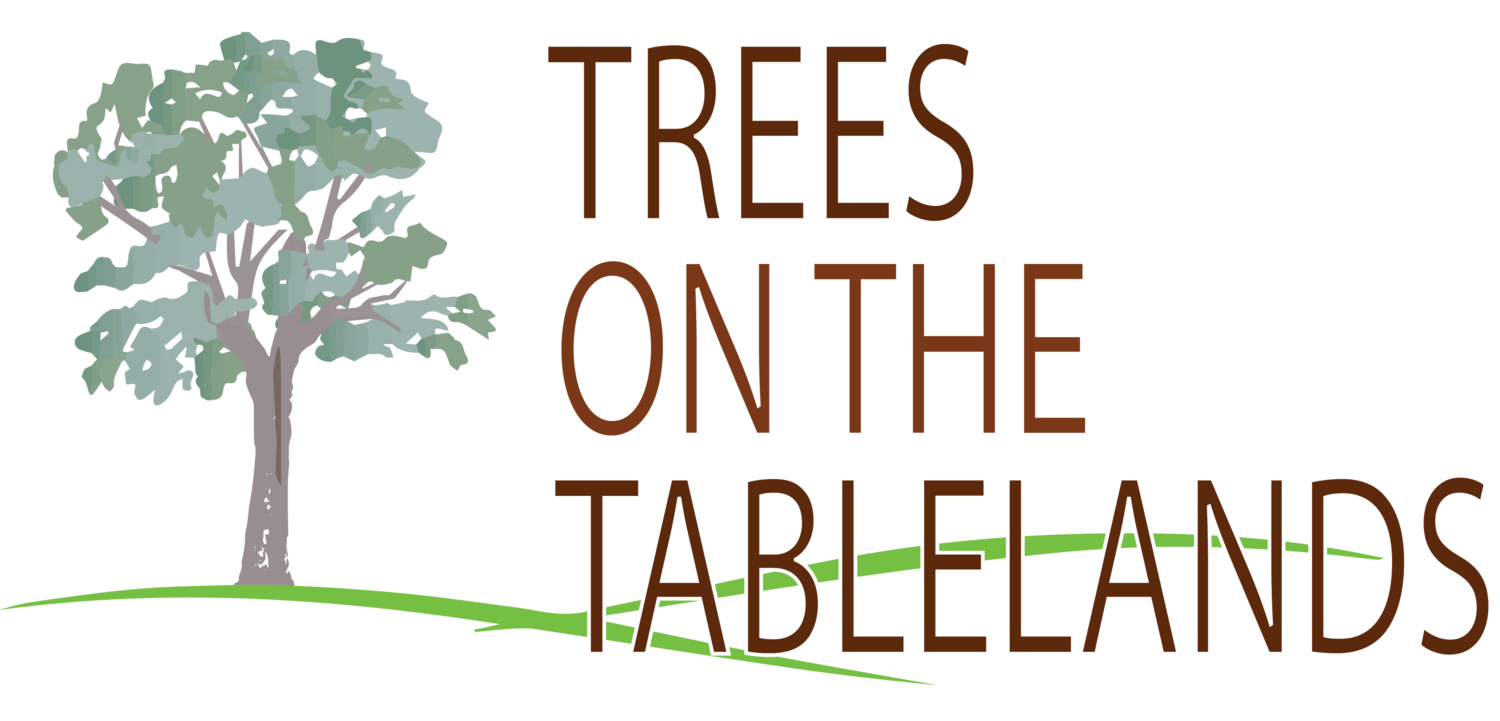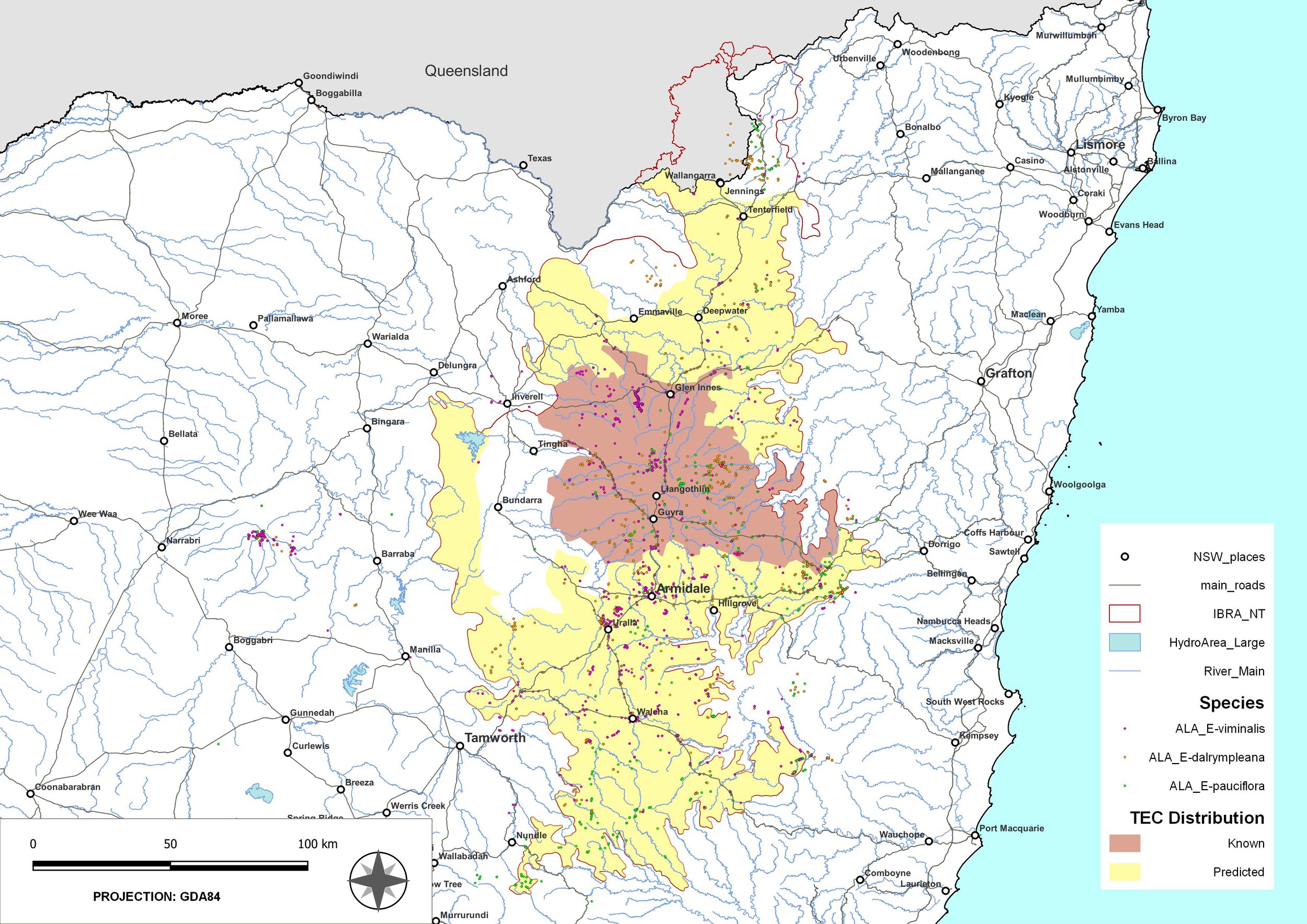Ribbon Gum - Mountain Gum - Snow Gum Grassy Forest/Woodland
Characteristics
Ribbon-gum – Mountain-gum – Snow-gum Grassy Forest/Woodland occurs across the Northern Tablelands bioregion on a variety of soil substrates, but primarily on undulating basalt loam soils at elevations between 700 to 1500 m (Benson & Ashby, 2000) (Figure 1). Due to extensive and continued disturbance from agriculture, clearing, and climate change, Ribbon-gum – Mountain-gum – Snow-gum Grassy Forest/Woodlands are classified as Threatened Ecological Communities (TECs) under the biodiversity conservation act of 1999 (DPIE, 2021; OEH, 2022). The classification of this ecological community is determined by the presence of any one of its three dominant White-gum species, Eucalyptus viminalis (Ribbon-gum), Eucalyptus dalrympleana subsp. Heptantha (Mountain-gum), Eucalyptus pauciflora (Snow-gum), in combination with or without a rich assemblage of shrubs and grasses in the above-ground understory and midstory, or below-ground seed bank. The composition of species within a site fluctuates dependent on the aspect, rainfall, soil depth, and exposure to historic disturbances such as grazing, clearing, or fire. The overstory may be composed of a single species or co-dominant with another, with some stands reaching heights of 30 m when conditions are favourable, but more commonly 15 to 20 m. While each of the three White-gum species presents smooth bark with a classic whiteish to yellow ‘gum’ appearance, each species has a distinctively different structural habit and landscape position. Ribbon-gum and Mountain-gum are often found occupying mid to upper slopes, while Snow-gums prefer cold valleys or rocky mountainous regions at elevations between 1000 to 1400 m. Other tree species often found within this community might include Red-gum (Eucalyptus blakelyi), Yellow-box (Eucalyptus melliodora), and Rough-barked Apple (Angophora floribunda). Midstory and understory elements vary considerably between sites but may be occupied by a layer of shrubs (often Acacias), and a rich understory composed of grasses and herbs (DPIE, 2021). Where historic or ongoing grazing and inappropriate fire regimes are present, midstory and understory elements may become heavily infested with weedy exotic grasses and shrubs. In severe cases, weed infestation can considerably reduce ecological functions within the community, impacting recruitment and survival of juvenile trees. When disturbance over extensive periods reduces woodland function and structure, native species of fauna such as Koala, pollinators, and various woodland songbirds are in turn affected.
Figure 1: Ribbon gum – Mountain gum – Snow gum Grassy Forest/Woodland distribution showing known and predicted populations across the Northern Tablelands of New South Wales, Australia. Occurrence data was obtained from the Atlas of Living Australia, and the Office of Environmental Heritage (ALA, 2022; OEH, 2021)
Threats
Throughout the Northern Tablelands, Ribbon-gum – Mountain-gum – Snow-gum Grassy Forest/Woodlands have been subjected to extensive clearing and fragmentation since agricultural settlement 130 years ago, as such less than 16% of their original distribution remains today (OEH, 2022) (Figure 1). Remaining communities are often comprised of small, heavily fragmented populations that have been radically transformed in under-story and mid-story structure due to grazing and repeated clearing events. Where pressures from agricultural activity have restricted natural recruitment, many populations are now disproportionately comprised of senescing adult trees with few young adults or saplings emerging. This presents a significant problem to the long-term persistence of White gum woodlands as the occurrence of favourable conditions to support natural recruitment is typically an infrequent event in the harsh Tablelands climate. Furthermore, as climate change is predicted to intensify local environmental conditions across Australia, it is increasingly likely that the current threat levels impacting White gum TECs will in turn increase (CSIRO, 2020).
The University of New England is currently working on a number of projects that aim to conserve and better understand the ways in which populations are likely to respond to a changing climate. Due to the majority of remaining populations occupying private lands, local landholders have a unique opportunity to play a pivotal role in conserving and expanding this unique woodland community. To learn more about how you can contribute, see our techniques and resources sections.
References
Atlas of Living Australia (ALA) (2022). Occurrence data for Eucalyptus viminalis, E. dalrympleana, E. pauciflora on the New England Tablelands.
Benson, J.S. & Ashby, E.M. (2000) Vegetation of the Guyra 1:100 000 map sheet New England Bioregion, New South Wales. Cunninghamia 6(3): 747-872
CSIRO, (2020). Climate change in Australia. Retrieved from: https://www.csiro.au/en/research/environmental-impacts/climate-change/climate-change-information accessed on 17 June 2022.
DPIE – Department of Agriculture, Water, and the Environment (2021). Ribbon-gum – Mountain-gum – Snow-gum Grassy Forest/Woodland EPBC Act Listing. Retrieved from: https://www.environment.nsw.gov.au/topics/animals-and-plants/threatened-species/nsw-threatened-species-scientific-committee/determinations/final-determinations/2004-2007/ribbon-gum-mountain-gum-snow-gum-grassy-forest-woodland-endangered-ecological-community-listing accessed on 17 June 2022.
OEH – Office of Environment & Heritage (2022). Ribbon gum - mountain gum - snow gum grassy forest/woodland of the New England Tableland Bioregion - endangered ecological community listing. Retrieved from https://www.environment.nsw.gov.au/threatenedspeciesapp/profile.aspx?id=20040#Threats accessed on 17 June 2022.
The following tree profiles describe the community composition of Ribbon-gum – Mountain-gum – Snow-gum grassy woodlands when each species is dominant.




